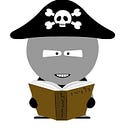Introducing Mark Twain
“Learning by impersonation”
Given my white hair and bushy eyebrows, I have heard more than a few times that I look like Mark Twain. This resemblance is a source of amusement to my friends. A few months ago we went to see Hal Holbrook in “Mark Twain Tonight,” his famous show where he impersonates Sam Clemens. The joke among my friends was that at the intermission I got more requests for autographs than Hal Holbrook.
It has been my experience (and that of Holbrook) that folks want to know about the life of the beloved man who wrote those books about Tom Sawyer and Huckleberry Finn. If the curious are adults, I send them in the direction of Justin Kaplan’s solid biography Mr. Clemens and Mark Twain, but if they’re youngsters I point them to Sid Fleischman’s The Trouble Begins at 8. Fleischman’s amusing work is subtitled “A Life of Mark Twain in the Wild, Wild West.” And that’s where it all began.
Sam Clemens grew up in Hannibal, Missouri (it would later become “St. Petersburg” in his books). Bored in this sleepy hamlet, the young Sam hatched a plan to make his first million by importing coca (a then legal stimulant taken for listlessness). So, he made a riverboat trip to New Orleans with the idea of traveling on from there to South America where he would set up business. But he got distracted. By the time he got to New Orleans, this bored boy from a sleepy hamlet, this backwoods youth looking for a cure to listlessness, had discovered excitement at last–in the glamorous world of steamboat pilots! He decided to become one.
Clemens called his years as a steamboat pilot the happiest of his life, but they were brought to an early end when the Civil War broke out and the rivers were shut down to traffic. So, Sam promptly signed up for the Confederate Army; he quit two weeks later–as he said, after learning all he could about retreating. He joined his older brother Orion who was heading to Nevada as Territorial Secretary. Out West, Sam tried his hand at prospecting, started a forest fire, and eventually turned to journalism, making ends meet by writing about such things as jumping-frog contests and adopting the name “Mark Twain” (a term used to describe the depth necessary for the safe passage of a steamboat).
Leaving Nevada, he became a humorist on the lecture circuit and eventually traveled to Europe; he would write about that trip in his hilarious and best-selling book Innocents Abroad. On his return, he met and eventually married Livy Langdon, and they set up home in their famous steamboat-like mansion in Hartford, Connecticut. They were living there in 1876 when The Adventures of Tom Sawyer was published and when “Mark Twain” became a name associated with children’s books.
The most famous scene in Tom Sawyer is, of course, the “whitewashing of the fence” where Tom is faced with a boring chore and hoodwinks his friends so that they pay for the privilege of painting the fence. Tom Sawyer is a sunny book full of comic scenes like this and incidents that remind you of childhood: superstitions, warts, playing hooky, pretending to be pirates, boring school recitals, and playground romances with girls like Becky Thatcher. The next novel was different.
Adventures of Huckleberry Finn is a darker book and probably meant for older readers. To be sure, it is often remembered as a summer’s tale about a barefoot boy and an escaped slave riding a raft down the Mississippi and trailing their feet in the water; and perhaps it is just that kind of story for young readers. But growing older, many will come to realize that–as Lionel Trilling said–this book is “America’s most eloquent argument against racism.” Indeed, if the central moment in Tom Sawyer is where Tom is admired for tricking his friends into whitewashing, the most important moment in Huckleberry Finn is its opposite: where Huck plays a trick on Jim and Jim calls the boy out for treating a friend like that. As Huck later explains, he got down on his knees and apologized to Jim and “weren’t never sorry for it afterwards.”
The third of Twain’s three great children’s books is The Prince and the Pauper, a novel that I have a special fondness for and that was written in tandem with Huckleberry Finn. In one book Twain unwinds Huck’s racism when, after his apology to Jim, Huck comes to the slow realization that “black folks have feelings same as white folks do.” In the other book, Twain unwinds the prejudices of class because once the prince exchanges clothes and places with the pauper, this member of the royalty comes to learn that poor folks have feelings same as rich folks do. The prince learns this by living, as it were, in another’s skin. You might call this learning by impersonation.
That’s a lovely phrase: “learning by impersonation.” Hal Holbrook has said that has been the great thing about playing Mark Twain night and after night. Of course, “Mark Twain” was the impersonation played by Samuel Clemens. Finally, let me add, “learning by impersonation” is also a wonderful description of reading.
A version of this essay originally appeared in Parents’ Choice. My enthusiasm for Twain spills over into three of the twelve chapters of my “Audacious Kids”:
Some of my related essays include:
If you liked this, “clap” below so others will see this on Medium. To see the ten most popular entries on this blog, click here. And if you’d like to read more essays like this, click the “follow” button at the top of this page.
Twitter: twitter.com/Jerry_Griswold
Facebook: www.facebook.com/griswold.jerry
